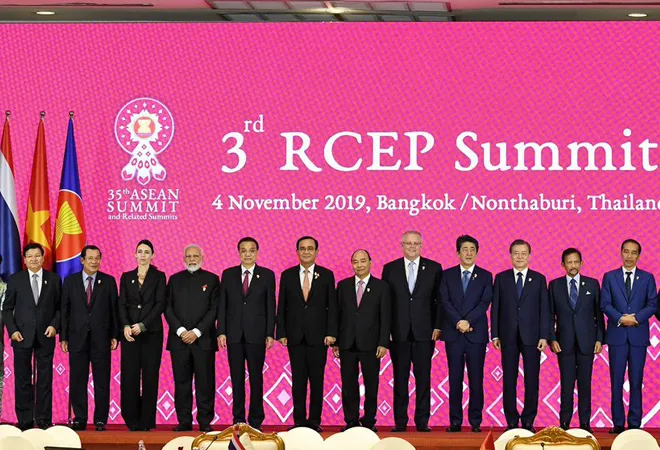As China managed to convince the ASEAN this week to move forward with the Regional Comprehensive Economic Partnership (RCEP), great power politics was clearly the elephant in the room at the summit in Bangkok, Thailand. The US-China contestation was out in the open once again at the annual East Asia Summit (EAS) and ASEAN was forced to respond to it in a manner where it has to balance the contending claims of two major powers.
The Trump administration has overturned decades of political consensus in Washington about integrating China in the global order. It is now openly confronting China at multiple levels. Most significant of the problems is in trade where the tariff war between the two most powerful economic powers has escalated. China’s economy has been hurt and its growth rate has fallen. Despite a trade pact between China and the US on the horizon, the two powers are trying to shape regional geopolitics in the Indo-Pacific to their own ends.
Yet where China managed to present itself as a positive actor trying to shape regional economic future via RCEP, questions abound about America’s commitment to the region and if ASEAN at all figures in Trump administration’s strategic priorities. This was most visibly manifest in Washington’s decision to downgrade its presence at the EAS to the lowest level since the Obama administration joined it in 2011. While US President Donald Trump managed to attend in 2017, he sent Vice President Mike Pence last year, and followed it up by sending the lowest-ranking delegation to the EAS, led by White House national security adviser Robert O’Brien.
This was seen as a snub by most ASEAN member states who reciprocated by downgrading their level of representation at the US-ASEAN Summit. While the leaders of Thailand, Vietnam, and Laos attended the summit, other seven member states sent their foreign ministers. The ASEAN states got Trump’s invitation for a special summit in early 2020 in the US which would provide ‘an excellent opportunity’ for leaders to ‘broaden and deepen our cooperation on matters of great importance’. It remains to be seen if Washington follows this up and if the summit that it has proposed delivers some concrete results.
Whatever be the case there, it is clear that Southeast Asia is preparing for a different regional order when the US centrality to the region would be not that significant. This despite the fact that the US State Department suggesting that ‘President Donald J Trump has made US engagement in the Indo-Pacific region a top priority of his administration.’
The region’s concerns have been growing since Trump’s decision to withdraw from Trans-Pacific Partnership and Trump’s stress on ‘America First’ policy at a time when China has been all out in wooing the region, emerging as ASEAN’s largest-trading partner for the last decade with bilateral trade reaching $580 billion and mutual investment more than $200 billion.
Strategically, China is now facing a stronger pushback in the wider Indo-Pacific where regional powers are arranging themselves in new coalitions to challenge China’s aggressive projection of its power. Like-minded countries see a need for a new security architecture in the region which can manage China’s rise. While a formal system will take time to emerge, informal coalitions are now growing in numbers and issue-based coalitions are the norm. With the credibility of the US declining, regional states are now willing to shoulder greater burden themselves.
It is against this backdrop that India-ASEAN strategic co-operation assumes greater significance. While India’s decision not to join RCEP will lead to many questioning India’s Indo-Pacific vision, structural changes shaping the region are having a significant impact on the way regional actors are re-evaluating their external outreach. This will continue to underscore India’s regional relevance.
India has welcomed the ASEAN’s outlook on the Indo-Pacific as it sees ‘important elements of convergence’ with its own approach towards the region. India has been categorical that it is ‘for something’ in the Indo-Pacific and ‘not against somebody’, seeking to carefully calibrate its relations with the US and China in this geopolitically critical region. As External Affairs Minister S Jaishankar suggested “
that something is peace, security, stability, prosperity and rules”.
With the ASEAN finally coming to terms with its own role in the Indo-Pacific, the ball is now in the court of other regional stakeholders to work with the regional grouping to shape a balance of power in the region which favours inclusivity, stability and economic prosperity.
India needs to do a more convincing job as a beneficial strategic partner of the ASEAN by boosting its domestic economic reforms agenda, enhancing connectivity within the region, and increasing its presence in regional institutions. The ASEAN nations too should be clearer and more specific in their expectations from New Delhi and nudge India for a deeper, more broad-based engagement. Despite the RCEP setback, there is much at stake for both sides.
This commentary originally appeared in Money Control
The views expressed above belong to the author(s). ORF research and analyses now available on Telegram! Click here to access our curated content — blogs, longforms and interviews.

